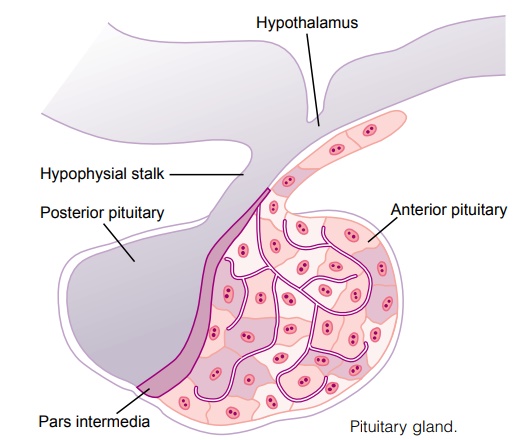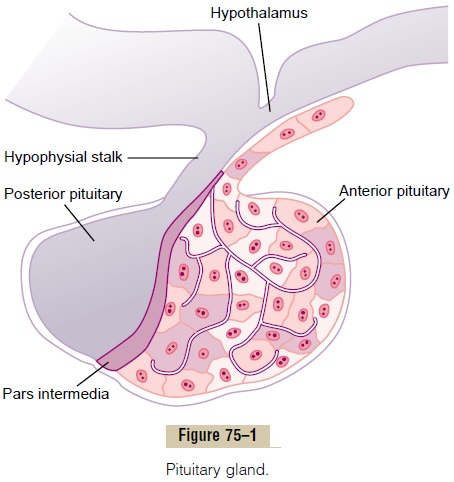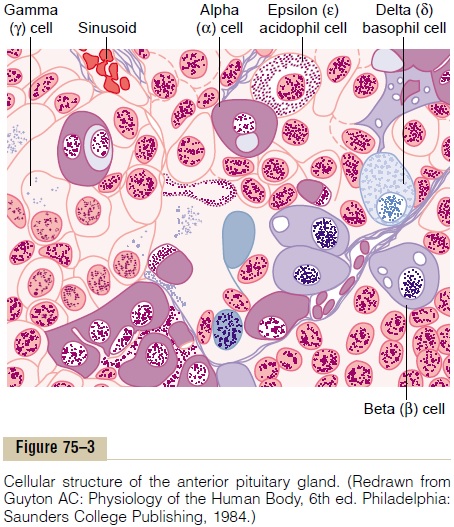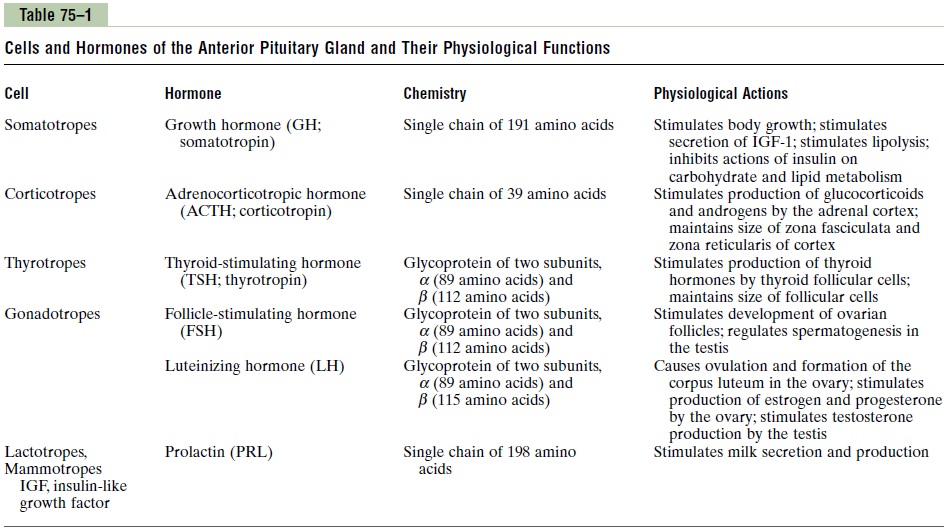Chapter: Medical Physiology: Pituitary Hormones and Their Control by the Hypothalamus
Pituitary Gland and Its Relation to the Hypothalamus

Pituitary Gland and Its Relation to the Hypothalamus
Pituitary Gland: Two Distinct Parts–The Anterior and Posterior Lobes. Thepituitary gland(Figure 75–1), alsocalled the hypophysis, is a small gland—about 1 cen-timeter in diameter and 0.5 to 1 gram in weight— that lies in the sella turcica, a bony cavity at the base of the brain, and is connected to the hypothalamus by the pituitary (or hypophysial) stalk. Physio-logically, the pituitary gland is divisible into two distinct portions: the anteriorpituitary, also known as the adenohypophysis, and the posterior pituitary, alsoknown as theneurohypophysis. Between these is a small, relatively avascular zone called the pars intermedia, which is almost absent in the human being but is much larger and much more functional in some lower animals.

Embryologically, the two portions of the pituitary originate from different sources—the anterior pituitary from Rathke’s pouch,which is an embryonic invagination of the pharyngeal epithelium, and the posterior pituitary from a neural tissue outgrowth from the hypothalamus. The origin of the anterior pitu-itary from the pharyngeal epithelium explains the epithelioid nature of its cells, and the origin of the posterior pituitary from neural tissue explains the pres-ence of large numbers of glial-type cells in this gland.
Six important peptide hormones plus several less important ones are secreted by the anterior pituitary, and two important peptide hormones are secreted by the posterior pituitary. The hormones of the anterior pituitary play major roles in the control of metabolic functions throughout the body, as shown in Figure 75–2.

· Growth hormone promotes growth of the entire body by affecting proteinformation, cell multiplication, and cell differentiation.
· Adrenocorticotropin (corticotropin) controls the secretion of some of theadrenocortical hormones, which affect the metabolism of glucose, proteins, and fats.
· Thyroid-stimulating hormone (thyrotropin) controls the rate of secretion ofthyroxine and triiodothyronine by the thyroid gland, and these hormones control the rates of most intracellular chemical reactions in the body.
· Prolactin promotes mammary gland development and milk production.
· Two separate gonadotropic hormones, follicle-stimulating hormone and luteinizing hormone, control growth of the ovaries and testes, as well astheir hormonal and reproductive activities.
The two hormones secreted by the posterior pituitary play other roles.
· Antidiuretic hormone (also called vasopressin) controls the rate of waterexcretion into the urine, thus helping to control the concentration of water in the body fluids.
· Oxytocin helps express milk from the glands of the breast to the nipplesduring suckling and possibly helps in the delivery of the baby at the end of gestation.
Anterior Pituitary Gland Contains Several Different Cell Types That Synthesize and Secrete Hormones. Usually, there is one cell type for each major hormone formed in the anterior pituitary gland. With special stains attached to high-affinity antibodies that bind with the distinctive hormones, at least five cell types can be differentiated (Figure 75–3). Table 75–1 provides a summary of these cell types, the hormones they produce, and their physio-logical actions. These five cell types are:
1. Somatotropes—human growth hormone (hGH)
2. Corticotropes—adrenocorticotropin (ACTH)
3. Thyrotropes—thyroid-stimulating hormone (TSH)
4. Gonadotropes—gonadotropic hormones, whichinclude both luteinizing hormone (LH) and follicle-stimulating hormone (FSH)
5. Lactotropes—prolactin (PRL)

About 30 to 40 per cent of the anterior pituitary cells are somatotropes that secrete growth hormone, and about 20 per cent are corticotropes that secrete ACTH. Each of the other cell types accounts for only 3 to 5 per cent of the total; nevertheless, they secrete powerful hormones for controlling thyroid function, sexual func-tions, and milk secretion by the breasts.

Somatotropes stain strongly with acid dyes and are therefore called acidophils. Thus, pituitary tumors that secrete large quantities of human growth hormone are called acidophilic tumors.
Posterior Pituitary Hormones Are Synthesized by Cell Bodies in the Hypothalamus. The bodies of the cells that secretethe posterior pituitary hormones are not located in the pituitary gland itself but are large neurons, called mag-nocellular neurons, located in the supraopticand par-aventricular nuclei of the hypothalamus. The hormonesare then transported in the axoplasm of the neurons’ nerve fibers passing from the hypothalamus to the pos-terior pituitary gland.
Related Topics